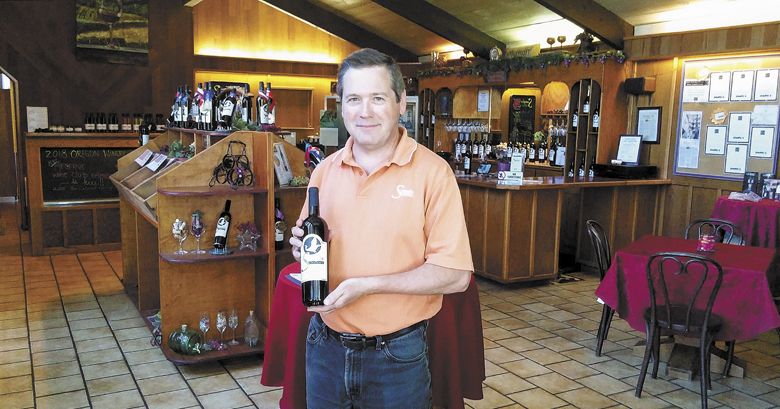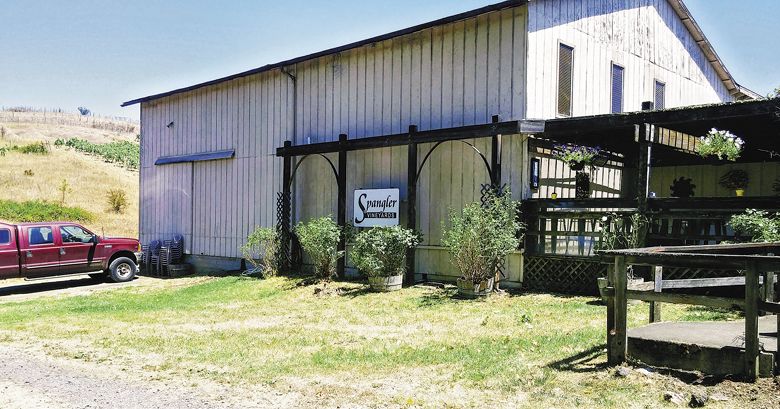From Oregon, With Love
Passion for Chianti unites two wine valleys
In an era of American Viticultural Area (AVA) proliferation and labeling battles in the Oregon Legislative Assembly, it’s refreshing to come across a bottle of wine with one simple yet powerful word on the front label: Oregon.
Federal rules allow Patrick Spangler to slap “Columbia Valley AVA” on the packaging of his 2014 Spangler Vineyards Sangiovese ($29). Instead, he opts for simplicity. “I intentionally use ‘Oregon’ to keep the focus on the wine rather than the area the grapes come from,” Spangler says. His wine is a blend of 92.5% Sangiovese from the Columbia Valley AVA and 7.5% Cabernet Sauvignon from his estate vineyard just south of downtown Roseburg in the Umpqua Valley AVA.
“I like to drink Chianti, but I have Cabernet Sauvignon, Dolcetto and Syrah growing on my property,” Spangler says. “So if I find great Sangiovese grapes somewhere else and need to bring them here to make wine, that’s what I’m going to do.”
The Sangiovese grapes are the Grosso, aka Brunello, clone. The vines were planted almost 15 years ago by Scott Elder in a plot of calcareous soil near The Dalles. The vineyard’s name is Rock Flour Hill, and its calcium-rich, steep, wind-blown slopes make an ideal home for Sangiovese.

The Cabernet Sauvignon grapes in the blend originate from 50-year old vines planted from 1968 to 1971 by a previous owner of the property, Harley Widener. In the early 1970s, three couples from California purchased the property and started a commercial winery, Jonicole Vineyards. They used grapes from Widener’s vines to make several award winners in the mid-1970s.
Jonicole’s winemaker, Jon Marker, also worked for Richard Sommer at nearby HillCrest Vineyard. “Paul Bjelland convinced Harley to plant the Cabernet Sauvignon so he could buy the fruit for his winery,” Marker says. “[The grapes] came from HillCrest, and I think they were certified Louis P. Martini vines Richard brought up from California.”
After Jonicole closed in the ’80s, Donna Souza-Postles revitalized the site in 1991, naming it La Garza Cellars. She also made excellent Cabernet Sauvignon for many years. Spangler, a son of Mount Blanchard, Ohio, who made a career on the Chicago Mercantile Exchange, purchased the winery and vineyard from the Souza-Postles family in 2004.
Over the past decade, Spangler developed a reputation for making excellent wines for a fair price. This Sangiovese is no exception.
“Everything I do is geared toward keeping Sangiovese’s aromatics and flavors intact while keeping the tannins down,” Spangler says. He manages this with a three-day cold soak and cooler fermentation temperatures. After eight days on the skins and before dryness is achieved, the juice is pressed off, and moved to tank to finish fermentation. After two months, the wine rests in barrel for 16 months.
The only sulfur this wine receives are the 30 parts per million added by Spangler during racking. “Sulfur can do useful things for wine, but I think we’ve moved too far in the wrong direction,” he says. “Go back and look at old wine books, and you will see people used to use far less.”
Another notable aspect of this Sangiovese is the vintage date. Spangler bottled it in June 2016 and held it at the winery for three years before recently releasing it to the public. “It needs the time, but even then the wine is still tight,” he says — I decanted the wine for two hours before taking this tasting note.
The Sangiovese appears a deep ruby color with only the tiniest cranberry-colored rim. Will it turn brickish orange over time? I certainly hope so.
I can smell the wine before I even pour it in my glass, beginning with a burst of red raspberries, followed by lilac, black olives and a note reminiscent of a Central Oregon hayfield after an easy rain. Spangler hit his goal of preserving Sangiovese’s aromatics.
A wild ride begins with the first sip. The red fruit tastes darker here, and flavors like bittersweet dark chocolate and blood orange make early appearances. The tannins are thick, and the roof of my mouth feels like corduroy. The pronounced acidity supplies a sense of balance with the fruit and tannins.
When I try the wine again two hours later, it feels smoother and tastes more savory, with new flavors of raspberry sorbet, cedar, seared steak and tobacco. The acidity is even more evident, giving the wine a nice slippery feel.
When I told Spangler I thought this wine could gracefully age for another decade, he laughed and said, “Try 20 years.” What a remarkable find for $29 a bottle. Just don’t wait too long to find it; Spangler made a mere 255 cases.
The Changeup, a monthly column by Michael Alberty, is a baseball pitch designed to disorient and confuse. It’s the perfect representation of the unknown and its mastery over those who think they know what to expect. This column is devoted to those unorthodox Oregon wines you never saw coming.












